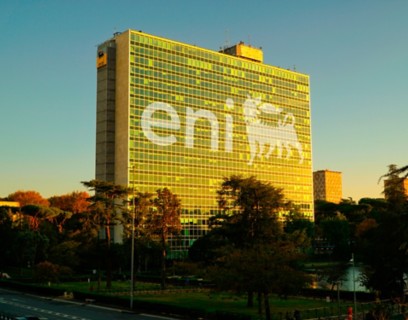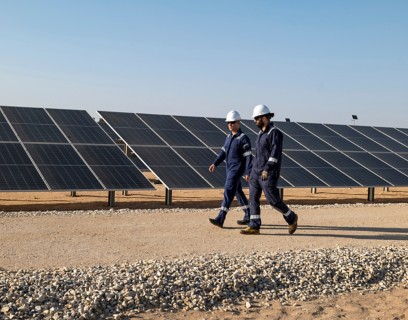
Financial and top risks
Financial risk management
Financial risks are managed in compliance with the guidelines issued by the Eni SpA Board of Directors in its role of guiding and defining risk limits, aimed at centrally aligning and coordinating the policies of Group companies on financial risks ("Guidelines on the management and control of financial risks"). The 'Guidelines' define the key components of the management and control process for each risk such as the objective of risk management, the assessment methodology, the limit structure, the reporting model, and the hedging and mitigation tools.
Market risk
It consists of the possibility that changes in exchange rates, interest rates or commodity prices may adversely affect the value of assets, liabilities or expected cash flows. Market risk management is governed by the aforementioned ‘Guidelines’ and by procedures that refer to a centralised model for managing financial assets, based on the Operational Finance Structures (Eni Corporate’s Finance Department, Eni Finance International SA, Eni Finance USA Inc and Banque Eni SA, with the latter being within the limits imposed by banking regulations on ‘Concentration Risk’), as well as on Eni Trading & Shipping as regards commodity derivative activities.
More specifically, Eni Corporate’s Finance Department, Eni Finance International SA and Eni Finance USA Inc respectively guarantee the coverage of requirements and the absorption of financial surpluses for Eni's Italian, non-Italian and US-based companies.
Exchange rate
Exposure to the risk of fluctuations in exchange rates arises from the company's operations in currencies other than the euro (mainly the US dollar) and has a number of impacts:
- on the net profit as a result of the different significance of costs and revenues in foreign currencies from the time when the price conditions were defined (economic risk) and as a result of the conversion of trade or financial receivables/payables in foreign currencies (transaction risk)
- on the consolidated financial statements (net profit and shareholders' equity) due to the conversion of assets and liabilities of companies that prepare their financial statements in a functional currency other than the euro.
Generally speaking, an appreciation of the US dollar against the euro has a positive effect on Eni's operating profit and vice versa. Eni’s risk management aim is to minimise the transactional exchange rate risk and optimise the economic exchange rate risk associated with the commodity price risk. The risk arising from the accrual of income in foreign currency or from the translation of assets and liabilities of companies that prepare their financial statements in a functional currency other than the euro is not normally hedged, unless otherwise specifically assessed. Eni centralises exchange rate risk management, offsetting opposite exposures from the different business activities involved and hedging the residual exposure with the market, maximising the benefits of netting. In order to manage residual exposure, the 'Guidelines' allow for different types of derivative instruments to be used (particularly swaps and forwards, as well as currency options).
For further details, see the 2023 Annual Report - "Market Risk - Exchange Rate" section on page 309.
Interest rate
Fluctuations in interest rates affect the market value of the company's financial assets and liabilities and the level of net financial expenses. Eni’s risk management aim is to minimise the exchange rate risk in pursuit of the financial structure objectives defined and approved in the 'Financial Plan'. The Operational Finance Structures, based on the centralised finance model, collect Eni's financial requirements and manage the resulting positions, including structural transactions, in line with the objectives of the "Financial Plan" and ensuring that the risk profile is kept within defined limits. Eni uses interest rate derivative contracts, particularly interest rate swaps, to manage the balance between fixed-rate and variable-rate debt.
Commodities
Commodity price risk is identified as the possibility that fluctuations in the price of raw materials and commodities will cause big changes to Eni's operating margins, leading to an impact on the bottom line which would jeopardise the objectives defined in the four-year plan and budget. Commodity price risk can be traced to a number of exposure categories:
- strategic exposure: exposures identified directly by the Board as the result of strategic investment choices or outside the risk planning timeframe. They include, for example, the exposures associated with the production programme of proven and probable reserves, long-term gas supply contracts for the portion not balanced by sales contracts (which have already been entered into or planned), the portion of the refining margin that the Board identifies as a strategic exposure (the remaining volumes may be allocated to active margin management or asset-backed hedging activities), and minimum required stocks;
- commercial exposure: this type of exposure includes the contractualised components related to commercial/industrial activities and, when related to take-or-par commitments, the non-contractualised components related to the four-year plan timeframe and budget and any related risk management transactions. Commercial exposures are characterised by the presence of systematic risk management activities carried out on the basis of risk/return logic through the implementation of one or more strategies, and are subject to specific risk limits (VaR, strategy review thresholds and stop losses). Within commercial exposures, asset-backed hedging exposures are specifically identified, resulting from asset flexibility/options;
- proprietary trading exposure: transactions carried out on own account from an opportunistic perspective in the short term and normally not aimed at delivery, either in the physical markets or in the financial markets, with the aim of obtaining a profit on the occurrence of a favourable market expectation, in compliance with specific authorised risk limits (VaR, stop losses). Proprietary trading exposures include origination assets where the same cannot be linked to physical or contractual assets.
For further details, see the 2023 Annual Report - "Market Risk - Commodities" section on pages 309-310.
Strategic liquidity
The market risk arising from the management of the portion of the liquidity reserve referred to as 'strategic liquidity' is identified as the possibility that fluctuations in the price of invested instruments (bonds, money market instruments and mutual funds) will affect their value when they are sold or when they are measured at fair value on the balance sheet. The main purpose of building up and maintaining the liquidity reserve is to ensure the financial flexibility required to meet any extraordinary needs (e.g. difficulties in accessing credit, exogenous shocks, the macroeconomic framework and extraordinary transactions) and is sized to ensure coverage of short-term debt and medium/long-term debt due within a 24-month timeframe.
In order to regulate the investment activity of strategic liquidity, Eni has defined an investment policy with specific objectives and constraints, expressed in terms of the type of financial instruments that can be invested in, as well as operational, quantitative and duration limits; it has also identified a set of governance principles to be followed and introduced an appropriate control system.
For further details, see the 2023 Annual Report - "Market Risk - Strategic Liquidity" section on page 310.
Credit risk
Credit risk represents the company's exposure to potential losses due to a counterparty's failure to meet its obligations. Eni has defined credit risk management policies consistent with the nature and characteristics of the counterparties of commercial and financial transactions within the centralised finance model that has been adopted.
Eni has adopted a model to quantify and control credit risk based on the evaluation of the expected loss.
The expected loss is the value of the loss expected to be incurred on a claim against a counterparty, for which a probability of default is estimated and a recovery capacity on the claim past default is estimated through the loss given default.
Within the credit risk management and control model, credit exposures are split according to their nature into commercial exposures, substantially related to structured commodity contracts in Eni's core business, and financial exposures, substantially related to financial instruments used by Eni, such as deposits, derivatives and investments in securities.
For further details, see the 2023 Annual Report - "Market Risk - Credit Risk" section on page 312.
Liquidity risk
Liquidity risk is the risk that the company is unable to meet its payment commitments due to difficulties in raising funds (funding liquidity risk) or liquidating assets on the market (asset liquidity risk). The consequence of such an event is a negative impact on the net profit in the event that the company is forced to incur additional costs to meet its commitments or, as an extreme consequence, a situation of insolvency that jeopardises its ability to continue as a going concern.
Eni's risk management objectives include maintaining an adequate amount of resources readily available to cope with exogenous shocks (drastic changes in the scenario, restrictions on access to the capital market) or to ensure an adequate level of operational resilience to Eni's development programmes. To this end, Eni maintains a strategic liquidity reserve consisting mainly of short-term, highly liquid financial instruments, thus favouring a very low risk profile.
At present, the Group believes it has adequate sources of financing to meet its foreseeable financial needs through the availability of financial assets and credit lines as well as access to a wide range of types of financing at competitive costs through the credit system and capital markets.
For further details, see the 2023 Annual Report - "Market Risk - Credit Risk-Liquidity Risk" section on page 312.
Financial and top risks
Financial risk management
Financial risks are managed in compliance with the guidelines issued by the Eni SpA Board of Directors in its role of guiding and defining risk limits, aimed at centrally aligning and coordinating the policies of Group companies on financial risks ("Guidelines on the management and control of financial risks"). The 'Guidelines' define the key components of the management and control process for each risk such as the objective of risk management, the assessment methodology, the limit structure, the reporting model, and the hedging and mitigation tools.
Market risk
It consists of the possibility that changes in exchange rates, interest rates or commodity prices may adversely affect the value of assets, liabilities or expected cash flows. Market risk management is governed by the aforementioned ‘Guidelines’ and by procedures that refer to a centralised model for managing financial assets, based on the Operational Finance Structures (Eni Corporate’s Finance Department, Eni Finance International SA, Eni Finance USA Inc and Banque Eni SA, with the latter being within the limits imposed by banking regulations on ‘Concentration Risk’), as well as on Eni Trading & Shipping as regards commodity derivative activities.
More specifically, Eni Corporate’s Finance Department, Eni Finance International SA and Eni Finance USA Inc respectively guarantee the coverage of requirements and the absorption of financial surpluses for Eni's Italian, non-Italian and US-based companies.
Exchange rate
Exposure to the risk of fluctuations in exchange rates arises from the company's operations in currencies other than the euro (mainly the US dollar) and has a number of impacts:
- on the net profit as a result of the different significance of costs and revenues in foreign currencies from the time when the price conditions were defined (economic risk) and as a result of the conversion of trade or financial receivables/payables in foreign currencies (transaction risk)
- on the consolidated financial statements (net profit and shareholders' equity) due to the conversion of assets and liabilities of companies that prepare their financial statements in a functional currency other than the euro.
Generally speaking, an appreciation of the US dollar against the euro has a positive effect on Eni's operating profit and vice versa. Eni’s risk management aim is to minimise the transactional exchange rate risk and optimise the economic exchange rate risk associated with the commodity price risk. The risk arising from the accrual of income in foreign currency or from the translation of assets and liabilities of companies that prepare their financial statements in a functional currency other than the euro is not normally hedged, unless otherwise specifically assessed. Eni centralises exchange rate risk management, offsetting opposite exposures from the different business activities involved and hedging the residual exposure with the market, maximising the benefits of netting. In order to manage residual exposure, the 'Guidelines' allow for different types of derivative instruments to be used (particularly swaps and forwards, as well as currency options).
For further details, see the 2023 Annual Report - "Market Risk - Exchange Rate" section on page 309.
Interest rate
Fluctuations in interest rates affect the market value of the company's financial assets and liabilities and the level of net financial expenses. Eni’s risk management aim is to minimise the exchange rate risk in pursuit of the financial structure objectives defined and approved in the 'Financial Plan'. The Operational Finance Structures, based on the centralised finance model, collect Eni's financial requirements and manage the resulting positions, including structural transactions, in line with the objectives of the "Financial Plan" and ensuring that the risk profile is kept within defined limits. Eni uses interest rate derivative contracts, particularly interest rate swaps, to manage the balance between fixed-rate and variable-rate debt.
Commodities
Commodity price risk is identified as the possibility that fluctuations in the price of raw materials and commodities will cause big changes to Eni's operating margins, leading to an impact on the bottom line which would jeopardise the objectives defined in the four-year plan and budget. Commodity price risk can be traced to a number of exposure categories:
- strategic exposure: exposures identified directly by the Board as the result of strategic investment choices or outside the risk planning timeframe. They include, for example, the exposures associated with the production programme of proven and probable reserves, long-term gas supply contracts for the portion not balanced by sales contracts (which have already been entered into or planned), the portion of the refining margin that the Board identifies as a strategic exposure (the remaining volumes may be allocated to active margin management or asset-backed hedging activities), and minimum required stocks;
- commercial exposure: this type of exposure includes the contractualised components related to commercial/industrial activities and, when related to take-or-par commitments, the non-contractualised components related to the four-year plan timeframe and budget and any related risk management transactions. Commercial exposures are characterised by the presence of systematic risk management activities carried out on the basis of risk/return logic through the implementation of one or more strategies, and are subject to specific risk limits (VaR, strategy review thresholds and stop losses). Within commercial exposures, asset-backed hedging exposures are specifically identified, resulting from asset flexibility/options;
- proprietary trading exposure: transactions carried out on own account from an opportunistic perspective in the short term and normally not aimed at delivery, either in the physical markets or in the financial markets, with the aim of obtaining a profit on the occurrence of a favourable market expectation, in compliance with specific authorised risk limits (VaR, stop losses). Proprietary trading exposures include origination assets where the same cannot be linked to physical or contractual assets.
For further details, see the 2023 Annual Report - "Market Risk - Commodities" section on pages 309-310.
Strategic liquidity
The market risk arising from the management of the portion of the liquidity reserve referred to as 'strategic liquidity' is identified as the possibility that fluctuations in the price of invested instruments (bonds, money market instruments and mutual funds) will affect their value when they are sold or when they are measured at fair value on the balance sheet. The main purpose of building up and maintaining the liquidity reserve is to ensure the financial flexibility required to meet any extraordinary needs (e.g. difficulties in accessing credit, exogenous shocks, the macroeconomic framework and extraordinary transactions) and is sized to ensure coverage of short-term debt and medium/long-term debt due within a 24-month timeframe.
In order to regulate the investment activity of strategic liquidity, Eni has defined an investment policy with specific objectives and constraints, expressed in terms of the type of financial instruments that can be invested in, as well as operational, quantitative and duration limits; it has also identified a set of governance principles to be followed and introduced an appropriate control system.
For further details, see the 2023 Annual Report - "Market Risk - Strategic Liquidity" section on page 310.
Credit risk
Credit risk represents the company's exposure to potential losses due to a counterparty's failure to meet its obligations. Eni has defined credit risk management policies consistent with the nature and characteristics of the counterparties of commercial and financial transactions within the centralised finance model that has been adopted.
Eni has adopted a model to quantify and control credit risk based on the evaluation of the expected loss.
The expected loss is the value of the loss expected to be incurred on a claim against a counterparty, for which a probability of default is estimated and a recovery capacity on the claim past default is estimated through the loss given default.
Within the credit risk management and control model, credit exposures are split according to their nature into commercial exposures, substantially related to structured commodity contracts in Eni's core business, and financial exposures, substantially related to financial instruments used by Eni, such as deposits, derivatives and investments in securities.
For further details, see the 2023 Annual Report - "Market Risk - Credit Risk" section on page 312.
Liquidity risk
Liquidity risk is the risk that the company is unable to meet its payment commitments due to difficulties in raising funds (funding liquidity risk) or liquidating assets on the market (asset liquidity risk). The consequence of such an event is a negative impact on the net profit in the event that the company is forced to incur additional costs to meet its commitments or, as an extreme consequence, a situation of insolvency that jeopardises its ability to continue as a going concern.
Eni's risk management objectives include maintaining an adequate amount of resources readily available to cope with exogenous shocks (drastic changes in the scenario, restrictions on access to the capital market) or to ensure an adequate level of operational resilience to Eni's development programmes. To this end, Eni maintains a strategic liquidity reserve consisting mainly of short-term, highly liquid financial instruments, thus favouring a very low risk profile.
At present, the Group believes it has adequate sources of financing to meet its foreseeable financial needs through the availability of financial assets and credit lines as well as access to a wide range of types of financing at competitive costs through the credit system and capital markets.
For further details, see the 2023 Annual Report - "Market Risk - Credit Risk-Liquidity Risk" section on page 312.
Main risk and processing actions
Eni's top risk portfolio consists of 20 risks which are classified into:
Eni's top risks with respect to corporate objectives are shown below, with the specific actions indicated.
Strategic risk
Main risk events
Commodity Price Scenario, overwiew of risks deriving from unfavourable commodities price fluctuation (Brent, natural gas and other commodities) compared to planning assumptions.
Treatment measures
Focus on portfolio resilience and flexibility by monitoring traditional businesses cash generation, new businesses growth, portfolio and capital budgeting optimization;
- diversification of gas/LNG supply portfolio of contracts leveraging on the development of upstream and GGP integrated initiatives to exploit value from equity gas and portfolio optimization actions;
- active strategy of portfolio hedging in relation to market conditions;
optimization of plants’ set-up in the tradition businesses;
enhancement of biorefinery capacity through the conversion of traditional refineries and selective partnership in projects in differentiated geographical areas;
chemical portfolio focused on higher value-added products and markets; development of renewable/bio Chemical and recycle;
feedstock flexibility also by integrating the agribusiness and diversifying products through the SAF segment development;
maximization of value from power services and initiatives to promote the decarbonization of power generation;
maximization of synergies between renewable capacity development and power customer portfolio (integrated energy management and hedging with customer portfolio) and further revenues securitization by participating to auctions and PPA signing.
Main risk events
Fall in demand/competitive environment, relating to a market demand and supply imbalance or an increase in competitiveness leading to: (i) sale volumes reduction, (ii) increased difficulties in in preserving the customer base/developing growth initiatives, (iii) trigger adverse trends of finished products’ prices, (iv) fall in demand.
Treatment measures
Diversification of gas/LNG supply portfolio of contracts leveraging on the development of upstream and GGP integrated initiatives to exploit value from equity gas and portfolio optimization actions;
active strategy of portfolio hedging in relation to market conditions and geopolitical scenario evolution;
growth in the sustainable mobility business and selective development of the service stations network;
chemical portfolio differentiation towards higher value added products and development of the downstream chain towards compounding;
development of renewable and recycling chemical;
organic growth of the retail gas and power customers with progressive integration with renewable energy generation capacity and the development of distributed generation and energy efficiency services, as well as e-mobility;
strenghtening the market position in the renewables markets, mainly in the Countries were a retail activity is carried, by developing the pipeline of acquired projects, with specific focus on Spain and Italy.
Main risk events
Climate change, referred to the possibility of changes in the scenario/weather conditions determining risks related to the energy transition (legislative, market, technological and reputational risks) and physical risk for Eni business in the short, medium and long term.
Treatment measures
Structured governance with a key rule of the Board of Directors in managing the main issues related to the climate change, and specific committees supporting the Board; • Strategic Plan foreseeing operational actions for each business to sustain the industrial transformation and to reach targets in the short, medium and long term;
remuneration policy with shaort and medium terms incentive plans including targets related to the “climate strategy” in line with the strategic plan;
resilience through the flexibility of the Strategy, portfolio diversification by developing low carbon businesses and products, as well as assessment of the portfolio resilience through stress test based on low carbon scenarios;
three-year technological development plan, or anticipated in case of material technology gaps, and active collaboration on Domestic and international innovation ecosystems;
transparency in climate disclosure, proactive dialogue with stakeholders and support to international initiatives and monitoring of legislative and legal trends (see also investigations and hse procedures risks);
risk management process to identify and analyse assets exposed to potential prospective changes of natural events which could affect the operability and integrity of Eni’s assets.
External risk
Main risk events
Commercial credit risk, riferring to the possible non-fulfilment of obligations assumed by a counterparty, with impacts on the economic/financial situation and the achievement of the company’s targets.
Treatment measures
Centralised credit model and operative coordination in multi-business customer management;
risk-mitigating management actions: guarantees, factoring, insurance coverage;
systematic monitoring of entrusted counterparties’ risk indicators and timely alerting mechanisms.
Main risk events
Biological-risk related to the spread of pandemics and epidemics potentially impacting people, health systems and businesses.
Treatment measures
Eni Crisis Unit’s constant guidance and monitoring to align, coordinate and identify response actions;
preparation and implementation of a plan to react to health emergencies (Medical Emergency Response Plan - MERP) to be adopted by all Eni subsidiaries and employers. The plan is also defined in order to identify a business continuity plan;
information for staff and training campaigns;
technical-scientific guidance activities of the staff units to define prevention and treatment measures to be declined and implemented at the business level.
Main risk events
Geopolitical, impact of geopolitical issues on strategic actions and business operations.
Treatment measures
Institutional activities with relevant national and international counterparties to overcome crisis situations;
continuos environmental monitoring, mainly focused on critical political/institutional developments and regulatory issues which can potentially affect the businesses;
enhancement of Eni’s presence leveraging on sustainability’s initiatives, with particular focus on the economic and social issues of Countries where the Company operates.
Main risk events
Global security risk, relating to actions or fraudulent events which may negatively affect people and material and intangible assets.
Political and social instability, referring both to political and social instability, and to criminal/bunkering events within the Country towards Eni and its subsidiaries, with potential consequences in terms of lower production, delays in projects, potential damage to people and assets.
Credit & Financing Risk, related to the financial stress of the partners and delays in credit proceeds and recovery of the incurred costs.
Treatment measures
Portfolio geographical diversification;
engagement in national and international initiatives for the implementation of collaboration plans and response to potential threats involving companies;
mitigation treatments for security risks through specific projects and programs referring to some most sensitive areas/sites;
presence of a security risk management system supported by analysis of Country and site specific preventive measures and implementation of emergency plans aimed at maximum safety of people and the management of activities and assets;
signing of Country-specific repayment plans leveraging on proven contractual and/or financial instruments;
request for sovereign guarantees and letters of credit to protect credit positions.
Main risk events
Energy sector regulation, relating to impacts on operations and competitiveness of businesses associated with the evolution of the energy sector regulation.
Treatment measures
Monitoring of legislative and regulatory evolution; advocacy within the institutional processes of definition of new directives or regulations targeted to decarbonisation and energy security;
definition of strategic and operational actions in line with regulatory developments:
- geographical diversification of bio capacity, feedstock flexibilization and expansion of product portfolio (agro-biofeedstock development, biojet production);
- development of chemical from renewable sources, and development of the advanced mechanical recycling and technologies for chemical recycling.
Main risk events
Relationships with local stakeholders of the energy industry.
Treatment measures
Integration of targets and sustainability projects (i.e. Community Investment) within the Strategic Plan and the management incentive program;
continuous dialogue with stakeholders to disclose the Eni’s sustainable approach, also through social and local development projects and local content valorization;
collaboration agreements with national and international organizations towards Public Private Partnership (FAO, UNDP, UNESCO, UNIDO);
respect and promotion of Human Rights through the implementation of the Human Rights Management Model, impact analysis and the integration of Human Rights perspective in the business processes.
Main risk events
Permitting, relating to the occurrence of possible delays or failure to issue authorizations, renewals or permits by the Public Administration with impacts on project schedule and costs as well as implications for social, environmental, image and reputation issues.
Treatment measures
Constant dialogue with institutions and participation to parliamentary hearings;
continuous involvement of authorities and stakeholders on project objectives and progress from the early stages;
transfer and sharing of knowhow with the bodies involved, also through greater involvement of technical bodies;
supervision and monitoring of sectoral authorization procedures;
visits/inspections of sites by representatives of institutions;
Eni’s central platform to manage Permitting and Environmental Compliance process of the operating sites.
Operational risk
Main risk events
Risks relating to blow-out and other accidents affecting assets in the upstream segment, refineries and Chemical plants, or that could happen during transportation by sea and land of hydrocarbons and derivatives (i.e. fires, explosions, etc.), damaging people and assets, and effecting the company profitability and reputation.
Treatment measures
Insurance coverage;
careful prevention action (application of new technologies) and real time monitoring for wells;
proactive monitoring of incidents through the weak signals identification in the Process Safety area and completion of the actions resulting from Audits and Risk Assessments relating to Process Safety issues;
technological and operational improvements and continuous implementation of the Asset Integrity Management system to prevent accidents together with the increase in plant reliability;
vetting: management and coordination of relevant activities to asses, inspect and select ships, assignment of a rating for operators;
standard contract specifications in the maritime transport;
Contract Risk Management (Pre/Post award);
continuos training activities.
Main risk events
Cyber Security & Industrial espionage referring to cyber attacks aimed at compromising information (ICT) and industrial (ICS) systems, as well as the subtraction of Eni’s sensitive data.
Treatment measures
Centralized governance model of Cyber Security, with units dedicated to cyber intelligence and prevention, monitoring and management of cyber attacks;
Cyber Security Operation infrastructures and services strengthening;
enhancement of safeguards at subsidiaries outside Italy and industrial sites;
increased detection capacity by implementing specific IoC (Compromise Indicators) from institutional sources and Cyber Threat Intelligence providers;
promotion of the corporate culture in the Cyber Security also through targeted initiatives (phishing simulation);
stronger monitoring of security events.
Main risk events
Investigations and proceedings relating to climate change, environmental, health and safety issues.
Treatment measures
Legal defense in judicial and non-judicial venues;
organizational structures engaged in the legal assistance and supervision of national and international institutional relations on HSE and climate change issues;
continuous monitoring of regulatory developments and constant assessment of the adequacy of existing monitoring and control models;
strengthened process of assigning and managing assignments to external professionals through new methods to ensure transparency and traceability;
focused communication programs.


















